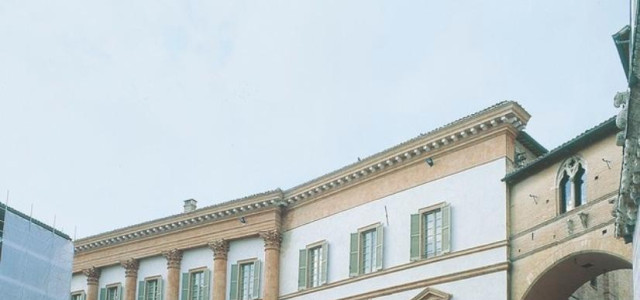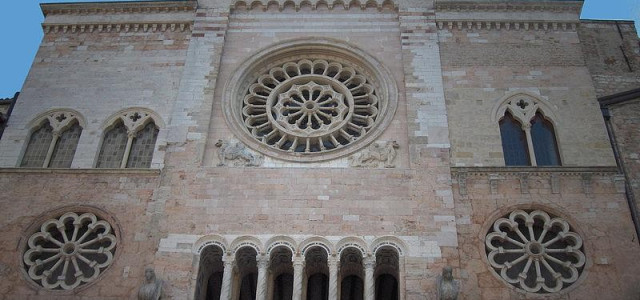Foligno
Foligno is an ancient town of Italy in the province of Perugia in east central Umbria, on the Topino river where it leaves the Apennines and enters the wide plain of the Clitunno river system. It is located 40 kilometres (25 miles) south-east of Perugia, 10 km (6 mi) north-north-west of Trevi and 6 km (4 mi) south of Spello. Foligno railway station forms part of the main line from Rome to Ancona, and is the junction for Perugia; it is thus an important rail center, with repair and maintenance yards for the trains of central Italy, and was therefore subjected to severe Allied aerial bombing in World War II, responsible for its relatively modern aspect, although it retains some medieval monuments. Of its Roman past no significant trace remains, with the exception of the regular street plan of the centre. Other resources include sugar refineries and metallurgical, textile, building materials and paper and timber industries. After the war, the city's position in the plain and again its rail connections have led to a considerable suburban spread with the attendant problems of traffic and air pollution, as well as a severe encroachment on the Umbrian wetlands. Foligno is on an important interchange road junction in central Italy and 2 km (1 mi) away from the centre of the city there is the Foligno Airport. History Foligno seems to have been founded by Umbrians in the pre-Roman period (probably 8th century BC). It was conquered by the Romans after the Battle of Sentinum in 295 BC, receiving the name of Fulginiae from the ancient cult of the goddess Fulginia. In the classic Roman age the city acquired importance first as a municipium, later as the seat of a prefecture and finally as a Statio principalis of road traffic along the ancient Via Flaminia. The city began to decay in the late Roman Empire years: after the fall of the latter, Fulginiae became part of the Duchy of Spoleto, and was sacked by the Saracens in 881 and ruined by Magyars in 915 and again in 924: its inhabitants therefore decided to move, settling around the nearby Civitas Sancti Feliciani (former Castrum Sancti Feliciani), a church strengthened by walls where the Bishop and martyr Feliciano was buried in the 3rd century AD and which was then already populated. The new seat had also attracted people from Forum Flaminii (now San Giovanni Profiamma), a neighbouring city that had been destroyed by the Lombards under Liutprand. Foligno recovered and continued to grow, ultimately gaining the status of free city in 1165 thanks to emperor Frederick Barbarossa. Siding first with the Guelph party, after its occupation by Corrado Guiscardo, a captain of emperor, Frederick II it became Ghibelline as a fierce rival of the Guelph Perugia. It changed hands often during the wars of the 13th century, until 1305 when it was seized by the powerful Guelph family of the Trinci, acting as semi-independent deputies of the Holy See. During this period Foligno flourished and reached the height of its wealth and, especially in the 15th century, was a center of art thanks to the family's patronage of arts (exemplified by the Palazzo Trinci). It controlled a large territory, including Assisi, Bevagna, Giano, Montefalco, Nocera and Spello. When Corrado Trinci turned against the Papal authority, Pope Eugene IV sent a force against Foligno in 1439, led by Cardinal Giovanni Vitelleschi. The inhabitants opened their gates and Corrado was beheaded in 1441 in the castle of Soriano. Henceforth Foligno belonged to the Papal States until 1860, with the exception of the Napoleonic era, when it was part of the Roman Republic (1799) then of the Kingdom of Italy (1809‑1814). The citizens took an active part in the Risorgimento wars, and on September 14, 1860 Savoy troops took the city and annexed it to the Kingdom of Italy. It has suffered from several major earthquakes, among which those of 1832 and 1997. Main sights Main monuments of the city include: Palazzo Comunale, built in the 13th century and rebuilt various times during the 16th and the 17th centuries. Its present Neo-Classical façade was carried out between 1835 and 1838. The bell tower is still the original from the 13th century. Adjoining the Palazzo Comunale is the Palazzo Orfini, built in Renaissance style, where the first printing shop opened by Emiliano Orfini around 1470. An inscription on the current façade (built in 1507) commemorates the printing in April 1472 of Dante's Divine Comedy here by Johann Neumeister, a former pupil of Gutenberg. This was the first book printed in the Italian language. The Duomo or Cathedral of San Feliciano (1133–1201): a Romanesque building (the interior, however, was completely reworked in the 18th century). There is a copy of original Saint Peter's baldachin designed by the Italian sculptor and architect Gian Lorenzo Bernini. The Church of S. Maria Infra Portas, the oldest church in town, although the present edifice dates to the 11th century. The Church of San Giacomo dates from 1402. Trinci Palace (1389–1407), which houses an archaeological museum, the city's picture gallery, a multimedia museum of Tournaments and Jousts and the Civic Museum. The façade was rebuilt in Neoclassicist style after the earthquakes in 1831-1832. It houses frescoes from the early 15th century, some attributed to Gentile da Fabriano. Ospedale Vecchio : a stately Renaissance building (1517–1520) with an eleven-arch portico on the Corso Cavour Palazzo Cantagilli (15th century), Palazzo Morotti (17th century) and Palazzo Roncalli (16th century) on the Corso Cavour Church of S. Agostino (18th century) : brickwork façade with four Corinthian columns (on the Piazza Garibaldi) Church of S. Salvatore (12 th century): the façade (14th century) was built with alternating rows of red and white stone and has three ogival portals. (on the Piazza Garibaldi) Church of the Suffragio (18th century) was built with a Greek cross-layout and an Ionic style façade. Oratory of Nunziatella, built in Renaissance style by (attributed to) Francesco di Bartolomeo da Pietrasanta after a miraculous event in 1489. The rectangular oratory contains two altars on the back wall and one altar on each sidewall with paintings from several periods. Its most famous painting is "Baptism of Jesus" by Perugino (1507), commissioned by Giovanni Battista Morganti. A fragment of the miraculous image of the Virgin was enclosed in a tabernacle of gilded wood. It was placed in front of a fresco by Giovanni Antonio Pandolfi da Pesaro (1575), representing the Holy Spirit among angels with St. Feliciano and the Blessed Pietro Crisci. The sacristy contains a damaged fresco of the Pietà, recently attributed to Giannicola di Paolo. In the same room stands the printing press on which the first edition of Dante's Divina Commedia was printed on 11 April 1472. The Abbey of Sassovivo, 5 km (3 mi) to the east, with cloisters of 1229 with pairs of small columns supporting arches, and Cosmatesque decorations. Culture The name of Foligno was famous for a noteworthy school of painting in the 15th century: it is also recorded for the famous Raphael's Madonna of Foligno (now in the Vatican), painted by the Urbinate artist for the nobleman Sigismondo di Comitibus, and for the first printed edition of Dante's Divina Commedia, printed on April 5 and 6 1472 in the Orfini Palace by Johannes Neumeister and Evangelista Mei. The city is also notable as the birthplace of Saint Angela of Foligno (1248–1309). Quarters The historical center of Foligno is traditionally divided into twenty rioni ("quarters"). Only ten of them are officially reckoned and can take part to the Giostra della Quintana. These are: Ammanniti Badia Cassero Contrastanga Croce Bianca Giotti La Mora Morlupo Pugilli Spada The "dead" rioni which had been absorbed within the former ones are: Borgo, Fonte del Campo, Cipischi, Croce, Falconi, Feldenghi, Franceschi, Menacoda, Piazza Vecchia, Spavagli. The Giostra della Quintana is a knight ring Jousting tournament based on a historical event. It takes place in the Town of Foligno - Central Italy. Actually the challenges take place in June (1st Challenge) during a Saturday night and September (the counter-challenge) the 2nd or 3rd Sunday of September. The definition of Quintana comes from the 5th road of the Roman military Camps, where the soldiers were trained to the lance fighting. They run against a dummy-soldier, trying to catch a ring hanging from an arm of the dummy. Here the origin of the Tournament's name, but the first definition and documented "Quintana" as a knights' jousting tournament during a festival, dates back to 1448. Since then, in Foligno, the "Quintana" was held uninterruptedly every year. In 1946 the actual "Giostra della Quintana" was reborn. In 1613 the Priors included the Quintana in the events of Carnival festivals, and all has been historically documented. The knights are 10, each representing a quarter of the Town. Rushing at gallop, they have to catch 3 rings having smaller size at each tournament. The rings are hanging from a rotating statue represent Mars the Lord of War from the Roman memories. The statue is in oak original dating back until 1613 (XVII° century) having a shield and a straight arm. A number of happenings involve the whole town and a parade of 800 persons dressed in original-like precious dresses walk in the town the day before the Joust takes place. Frazioni Abbazia di Sassovivo, Acqua Santo Stefano, Afrile, Aghi, Ali, Annifo, Arvello, Ascolano, Barri, Belfiore, Borgarella, Borroni, Budino, Camino, Cancellara, Cancelli, Cantagalli, Capodacqua, Caposomigiale, Cappuccini, Cariè, Carpello, Casa del Prete, Casa Pacico, Casale del Leure, Casale della Macchia, Casale di Morro, Casale di Scopoli, Cascito, Casco dell'Acqua, Casenove, Casette di Cupigliolo, Casevecchie, Cassignano, Castello di Morro, Castretto, Cavallara, Cave, Cerritello, Chieve, Cifo, Civitella, Colfiorito, Collazzolo, Colle di Verchiano, Colle San Giovanni, Colle San Lorenzo, Colle Scandolaro, Collelungo, Collenibbio, Colpernaco, Colpersico, Corvia, Costa di Arvello, Crescenti, Croce di Roccafranca, Croce di Verchiano, Cupacci, Cupigliolo, Cupoli, Curasci, Fiamenga, Fondi, Forcatura, Fraia, Hoffmann, La Franca, La Spiazza, La Valle, Leggiana, Liè, Maceratola, Maestà di Colfornaro, Modonna delle Grazie, Montarone, Morro, Navello, Orchi, Palarne, Pale, Perticani, Pescara I°, Pescara II°, Pieve Fanonica, Pisenti, Poggiarello, Polveragna, Ponte San Lazzaro, Ponte Santa Lucia, Pontecentesimo, Popola, Rasiglia, Ravignano, Rio, Roccafranca, Roviglieto, San Bartolomeo, San Giovanni Profiamma, San Vittore, Sant'Eraclio, Santo Stefano dei Piccioni, Scafali, Scandolaro, Scanzano, Scopoli, Seggio, Serra Alta, Serra Bassa, Serrone, Sostino, Sterpete, Tesina, Tito, Torre di Montefalco, Treggio, Uppello, Vallupo, Vegnole, Verchiano, Vescia, Vionica, Volperino. International relations Twin towns — Sister cities Foligno is twinned with: Gemona del Friuli, Italy La Louvière, Belgium Shibukawa, Japan References Valle Umbra - Storia, arte, cultura e tradizione. Foligno: Valle Umbra - Servizio Turistico Associato. 2006. Vigueur, Jean-Claude Maire (March 2007). "Foligno - Invito a palazzo". Medioevo (Novara: De Agostini Periodici) (122): 48–64. External links Official town's website Official Giostra della Quintana website Bill Thayer's site






